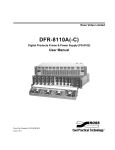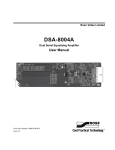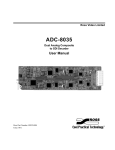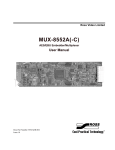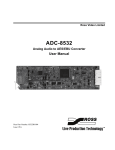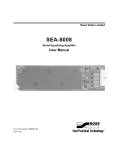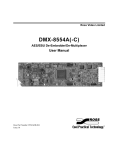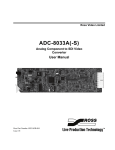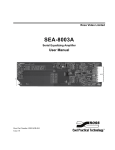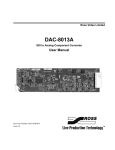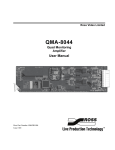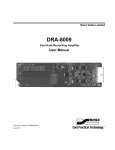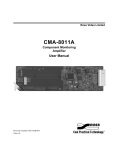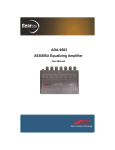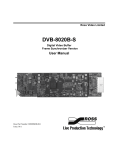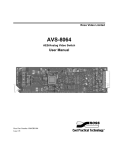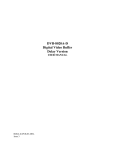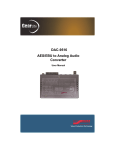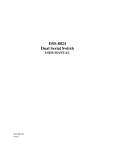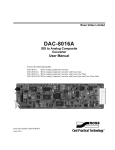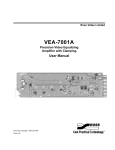Download Manual - Ross Video
Transcript
Ross Video Limited DAC-8516 24 Bit AES/EBU to Analog Audio Converter User Manual Ross Part Number: 8516DR-004 Issue: 05 DAC-8516 • 24 Bit AES/EBU to Analog Audio Converter User Manual • • • Ross Part Number: 8516DR-004 Document Issue: 05 Release Date: May 25, 2007. Printed in Canada. The information contained in this User Manual is subject to change without notice or obligation. Copyright © 2007 Ross Video Limited. All rights reserved. Contents of this publication may not be reproduced in any form without the written permission of Ross Video Limited. Reproduction or reverse engineering of copyrighted software is prohibited. Notice The material in this manual is furnished for informational use only. It is subject to change without notice and should not be construed as a commitment by Ross Video Limited. Ross Video Limited assumes no responsibility or liability for errors or inaccuracies that may appear in this manual. Trademarks • • • is a registered trademark of Ross Video Limited. Ross, ROSS, and MLE are registered trademarks of Ross Video Limited. All other product names and any registered and unregistered trademarks mentioned in this manual are used for identification purposes only and remain the exclusive property of their respective owners. ROSS ®, Important Regulatory and Safety Notices Before using this product and any associated equipment, refer to the “Important Safety Instructions” listed below so as to avoid personnel injury and to prevent product damage. Products may require specific equipment, and /or installation procedures be carried out to satisfy certain regulatory compliance requirements. Notices have been included in this publication to call attention to these Specific requirements. Symbol Meanings This symbol on the equipment refers you to important operating and maintenance (servicing) instructions within the Product Manual Documentation. Failure to heed this information may present a major risk of damage or injury to persons or equipment. Warning Caution Notice The symbol with the word “Warning” within the equipment manual indicates a potentially hazardous situation, which if not avoided, could result in death or serious injury. The symbol with the word “Caution” within the equipment manual indicates a potentially hazardous situation, which if not avoided, may result in minor or moderate injury. It may also be used to alert against unsafe practices. The symbol with the word “Notice” within the equipment manual indicates a situation, which if not avoided, may result in major or minor equipment damage or a situation which could place the equipment in a non-compliant operating state. This symbol is used to alert the user that an electrical or electronic device or assembly is susceptible to damage from an ESD event. ESD Susceptibility Important Safety Instructions Caution This product is intended to be a component product of the RossGear 8000A series frame. Refer to the RossGear 8000A series frame User Manual for important safety instructions regarding the proper installation and safe operation of the frame as well as it’s component products. Warning Certain parts of this equipment namely the power supply area still present a safety hazard, with the power switch in the OFF position. To avoid electrical shock, disconnect all A/C power cords from the chassis' rear appliance connectors before servicing this area. Warning Service barriers within this product are intended to protect the operator and service personnel from hazardous voltages. For continued safety, replace all barriers after any servicing. This product contains safety critical parts, which if incorrectly replaced may present a risk of fire or electrical shock. Components contained within the product’s power supplies and power supply area, are not intended to be customer serviced and should be returned to the factory for repair. To reduce the risk of fire, replacement fuses must be the same type and rating. Only use attachments/accessories specified by the manufacturer. EMC Notices US FCC Part 15 This equipment has been tested and found to comply with the limits for a class A Digital device, pursuant to part 15 of the FCC Rules. These limits are designed to provide reasonable protection against harmful interference when the equipment is operated in a commercial environment. This equipment generates, uses, and can radiate radio frequency energy and, if not installed and used in accordance with the instruction manual, may cause harmful interference to radio communications. Operation of this equipment in a residential area is likely to cause harmful interference in which case users will be required to correct the interference at their own expense. Changes or modifications to this equipment not expressly approved by Ross Video Ltd. could void the user’s authority to operate this equipment. Notice CANADA This Class “A” digital apparatus complies with Canadian ICES-003. Cet appareil numerique de classe “A” est conforme à la norme NMB-003 du Canada. EUROPE This equipment is in compliance with the essential requirements and other relevant provisions of CE Directive 93/68/EEC. INTERNATIONAL This equipment has been tested to CISPR 22:1997 along with amendments A1:2000 and A2:2002 and found to comply with the limits for a Class A Digital device. This is a Class A product. In domestic environments this product may cause radio interference in which case the user may have to take adequate measures. Notice Maintenance/User Serviceable Parts Routine maintenance to this RossGear product is not required. This product contains no user serviceable parts. If the module does not appear to be working properly, please contact Technical Support using the numbers listed under the “Contact Us” section on the last page of this manual. All RossGear products are covered by a generous 5-year warranty and will be repaired without charge for materials or labor within this period. See the “Warranty and Repair Policy” section in this manual for details. Environmental Information The equipment that you purchased required the extraction and use of natural resources for its production. It may contain hazardous substances that could impact health and the environment. To avoid the potential release of those substances into the environment and to diminish the need for the extraction of natural resources, Ross Video encourages you to use the appropriate take-back systems. These systems will reuse or recycle most of the materials from your end-of-life equipment in an environmentally friendly and health conscious manner. The crossed-out wheeled bin symbol invites you to use these systems. If you need more information on the collection, reuse, and recycling systems, please contact your local or regional waste administration. You can also contact Ross Video for more information on the environmental performances of our products. Contents Introduction 1-1 In This Chapter .......................................................................................................................1-1 A Word of Thanks....................................................................................................1-1 Overview ..................................................................................................................1-2 Functional Block Diagram .......................................................................................1-2 Features ....................................................................................................................1-3 Documentation Terms ..............................................................................................1-3 Installation and Setup 2-1 In This Chapter .......................................................................................................................2-1 Static Discharge........................................................................................................2-1 Unpacking ................................................................................................................2-1 Board Installation .....................................................................................................2-2 BNC Labels ..............................................................................................................2-2 DAC-8516 Cable Connections.................................................................................2-2 User Controls 3-1 In This Chapter .......................................................................................................................3-1 DAC-8516 Jumper Locations...................................................................................3-1 LEDs.........................................................................................................................3-2 SMPTE 269M Fault Reporting 4-1 In This Chapter .......................................................................................................................4-1 Overview ..................................................................................................................4-1 Jumper Setup ............................................................................................................4-2 Frame Connections...................................................................................................4-2 Details.......................................................................................................................4-2 Upgrades 5-1 In This Chapter .......................................................................................................................5-1 Equipment Supplied .................................................................................................5-1 Upgrade Procedures .................................................................................................5-1 Specifications 6-1 Technical Specifications.........................................................................................................6-1 DAC-8516 User Manual (Iss. 05) Contents • i Service Information 7-1 In This Chapter ...................................................................................................................... 7-1 Troubleshooting Checklist....................................................................................... 7-1 Warranty and Repair Policy .................................................................................... 7-2 Ordering Information 8-1 DAC-8516 and Related Products........................................................................................... 8-1 ii • Contents DAC-8516 User Manual (Iss. 05) Introduction In This Chapter This chapter contains the following sections: • A Word of Thanks • Overview • Functional Block Diagram • Features • Documentation Terms A Word of Thanks Congratulations on purchasing the Ross Video DAC-8516 AES/EBU to Analog Audio Converter. The DAC-8516 family is part of a full line of RossGear Digital products, backed by Ross Video’s experience in engineering and design expertise since 1974. You will be pleased at how easily your new DAC-8516 fits into your overall working environment. Equally pleasing is the product quality, reliability, and functionality. Thank you for joining the group of worldwide satisfied Ross Video customers! We recommend that you read the sections in this User Manual that are relevant to your particular card(s) before installation. In this way you will ensure its proper integration into your facility and maximize the features and functionality of the card. This manual provides installation and operational instructions for the DAC-8516. Should you have a question pertaining to the operation of your DAC-8516, please contact us at the numbers listed on the back cover of this publication. Our technical support staff is always available for consultation, training, or service. DAC-8516 User Manual (Iss. 05) Introduction • 1-1 Overview The RossGear DAC-8516 AES/EBU to Analog Audio Converter is a broadcast quality modular product used to convert 16 or 24 bit AES-3id (coaxial) signals to balanced analog audio. The DAC8516 accepts one 32, 44.1, 48, or 96 kHz AES audio signal. It provides two copies of stereo balanced analog audio through the rear plug-on module, the CON-8516 Analog Audio Connector Adapter. Visual indicators on the card edge provide information on the current status. The DAC-8516 provides automatic cable equalization for lengths up to and beyond 2000 ft. Each Analog Audio Output features a coarse level adjustment headroom jumper (18dB or 24dB) and a fine adjustment potentiometer (+/-6dB). Automatic detection of AES/EBU 50/15μs de-emphasis is available for 32, 44.1, and 48 kHz data rates. The DAC-8516 has card edge indicators to confirm lock to the input signal and to show the input sampling rate. It will also indicate a variety of AES signal errors including No Lock, Coding, Parity, CRC, and Validity errors. In addition, there is a SMPTE 269M fault reporting output to the back plane of the Ross frame. Fitting into the RossGear 2 RU DFR-8110A or 1RU DFR-8104A digital frame, the DAC-8516 is part of a growing line of RossGear Video, Audio, and AES solutions, including distribution, conversion, embedding, de-embedding and monitoring. Designed and manufactured to meet the highest quality broadcast industry standards, the RossGear DAC-8516 is an ideal, cost effective solution for AES/EBU to analog audio conversion. Functional Block Diagram Figure 1. Simplified Block Diagram of DAC-8516 Functions 1-2 • Introduction DAC-8516 User Manual (Iss. 05) Features The following features make the DAC-8516 one of the highest quality 24 Bit AES/EBU to Analog Audio Converters on the market today: • Terminating input 75Ω • Wide input range from 100mV to 2.5V p-p • Auto equalization for > 610m (2000 ft.) of Belden 8281 cable • Conformity to AES-3id 2003 • Support for any sampling rate in the 28 to 100 kHz range including 32, 44.1, 48, and 96kHz • Visual indication of signal presence • Visual indication of an error condition • Visual indication of sampling rate • 24-bit DAC resolution • Output levels adjustable from +12 to + 27 dBu • Two copies of the stereo output • Ten card capacity in the Ross DFR-8110A digital rack frame • Four card capacity in the Ross DFR-8104A digital rack frame • SMPTE fault reporting in accordance with SMPTE 269M • 5 year transferable warranty Documentation Terms The following terms are used throughout this guide: • “Frame” refers to the DFR-8104A and DFR-8110A frames that house the DAC8516 card. • All references to the DFR-8104A and DFR-8110A also include the DFR-8104A-C and DFR-8110A-C versions with the cooling fan option. See the respective User Manuals for details. • “Operator” and “User” both refer to the person who uses the DAC-8516. • “Board”, “Card”, and “Module” all refer to the DAC-8516 decoder board itself, including all components and switches. • “System” and “Video system” refers to the mix of interconnected digital and analog production and terminal equipment in which the DAC-8516 operates. DAC-8516 User Manual (Iss. 05) Introduction • 1-3 1-4 • Introduction DAC-8516 User Manual (Iss. 05) Installation and Setup In This Chapter This chapter contains the following sections: • Static Discharge • Unpacking • Board Installation • BNC Labels • Cable Connections Static Discharge Whenever handling the DAC-8516 and other related equipment, please observe all static discharge precautions as described in the following note: ESD Susceptibility Static discharge can cause serious damage to sensitive semiconductor devices. Avoid handling circuit boards in high static environments such as carpeted areas, and when wearing synthetic fiber clothing. Always exercise proper grounding precautions when working on circuit boards and related equipment. Unpacking Unpack each DAC-8516 you received from the shipping container, and check the contents against the packing list to ensure that all items are included. If any items are missing or damaged, contact your sales representative or Ross Video directly. DAC-8516 User Manual (Iss. 05) Installation and Setup • 2-1 Board Installation Refer to the following to install the DAC-8516 in a RossGear 8000A series digital distribution frame: • Refer to the User Manual of the RossGear 8000A series frame, to ensure that the frame is properly installed according to instructions. If this module is to be installed in any compatible frame other than a Ross Video product, refer to the frame manufacturer’s manual for specific instructions. Please note that heat and power distribution requirements within a frame may dictate specific slot placement of cards. Cards with many heat-producing components should be arranged to avoid areas of excess heat build-up, particularly in frames using convectional cooling. Note • After selecting the desired frame installation slot, hold the DAC-8516 card by the edges and carefully align the card edges with the slots in the frame. Then fully insert the card into the frame until the rear connection plug is properly seated. BNC Labels Affix the supplied BNC label, as per the included instructions, to the BNC area on the rear of the rack frame. DAC-8516 Cable Connections This section provides instructions for connecting cables to the DAC-8516 when mounted in RossGear 8000A series Digital Products Frames. Connect the input and output cables according to the frame rear panel connections in the following figure. It is not necessary to terminate unused outputs, inputs are internally terminated in 75 ohms. Figure 2. Digital Frame BNC and Audio Plug Cable Connections for DAC-8516 2-2 • Installation and Setup DAC-8516 User Manual (Iss. 05) AES Input The AES audio input should be connected to the “IN” BNC on the rear of the 1RU or 2RU frames. The DAC-8516 can accommodate any sample rate from 22k to 100 kHz. Analog Audio Output The DAC-8516 uses the CON-8516 Analog Audio Connector Adapter to access the balanced audio outputs. This connector attaches to BNCs 5, 6, 7, and 8 on the rear of the Ross DFR-8104A or DFR8110A frames. The CON-8516 Analog Audio Connector Adapter provides two copies of the analog audio signal via the removable outputs A-1, A-2, B-1, and B-2. Each connector has sockets for the positive, negative, and grounded wires of a balanced analog audio cable. Analog Cables On the CON-8516 analog audio connector adapter, there are removable connector sockets Analog A Out 1, Analog A Out 2, Analog B Out 1, and Analog B Out 2.- 1A, 1B, 2A, and 2B (labeled A-1, A-2, B-1, B-2 on the adapter). Each connector has sockets for the positive, negative, and grounded wires of a balanced analog audio cable. Figure 3. Connector Wiring for CON-8516 Analog Audio Connector Adapter Use the following procedure to wire the external cables to the terminal block connectors: 1. Insert an analog audio wire to the designated polarity slot on the connector. 2. Use a tweaker screwdriver to tighten the corresponding screw on the underside of the connector. 3. Repeat steps 1 and 2 for each wire on each connector. Once the cables have been wired to the connectors, install the connectors to the sockets on the CON-8516 Analog Audio Connector Adapter so that the slotted tongue fits in the grooves on the module socket. DAC-8516 User Manual (Iss. 05) Installation and Setup • 2-3 2-4 • Installation and Setup DAC-8516 User Manual (Iss. 05) User Controls In This Chapter This chapter contains the following sections: • Jumper Locations • De-Emphasis Jumper Setup • Coarse Level Jumper Setup • Fine Level Adjustment • SMPTE 269M Fault Report Jumper Setup • Audio Levels • LEDs DAC-8516 Jumper Locations Use the following information to set jumpers based on your configuration requirements. Figure 4. DAC-8516 Jumper Locations DAC-8516 User Manual (Iss. 05) User Controls • 3-1 De-Emphasis – JP1 De-Emphasis is configured by jumper JP1 – DE-EMP. The default is AUTO. The three settings are as follows: • ON — The DAC-8516 forces De-Emphasis according to the current sampling rate. • AUTO — The DAC-8516 applies a 50/15µs de-emphasis curve applied according to: • the current sampling rate • the AES Professional Channel Status Bits in byte 0. • OFF — No de-emphasis filtering. Coarse Analog Output Levels – JP3, JP4 On the CON-8516, select the coarse analog audio output headroom level (+18 or +24 dBu) for each channel. The default is +24 dBu. • JP3 selects for Max Left A Level dBu • JP4 selects for Max Right Level dBu Fine Level Adjustment – RV1, RV2 If necessary, use a tweaker screwdriver to make fine-level adjustments on each potentiometer within a range of +/-6dB, for each channel on the DAC-8516. • RV1 adjusts A channel output gain • RV2 adjusts B channel output gain See Figure 4 for potentiometer locations. All fine levels are factory set for unity gain and should not need adjusting. Note An extender card is required (EXT-8100) to adjust potentiometer settings. Refer to the section, “Optional Equipment” for details. SMPTE 269M Fault Report – JP2 Figure 2 describes the jumper mode selections that either enable or disable SMPTE 269M Fault Reporting. Select SMPTE 269M Fault Reporting, EN or DIS, via JP2. The default is EN. See Chapter 4, “SMPTE 269M Fault Reporting” for complete details. LEDs The front edge of the module has LED indicators, which show the status of the amplifier and input signals. They are described in the following figure and table. The module is operating correctly when the Input OK LED is lit. 3-2 • User Controls DAC-8516 User Manual (Iss. 05) Figure 5. DAC-8516 LEDs Table 1. DAC-8516 LED Status Indicator Descriptions LED Reference INPUT OK Green Status Description Indicates presence of a valid AES input signal, and the DAC-8516 has locked to the incoming digital AES audio amd shows the incoming signal is suitable for conversion to analog audio Indicates that the incoming AES stream is not suitable for conversion to analog audio. One or more of the following errors have been encountered: Red ERROR Flashing Red • No Lock ⎯ There was an error with the incoming signal • Coding ⎯ Bi-phase coding violation • Parity ⎯ There was a parity error Indicates that the incoming AES stream has encountered one or more of the following problems: • CRC ⎯ Error in the CRC calculation • Validity ⎯ The integrity of this sub-frame is in question 96 KHz Yellow Indicates sampling rate of input AES/EBU signal 48 KHz Yellow Indicates sampling rate of input AES/EBU signal 44.1 KHz Yellow Indicates sampling rate of input AES/EBU signal 32 KHz Yellow Indicates sampling rate of input AES/EBU signal DAC-8516 User Manual (Iss. 05) User Controls • 3-3 3-4 • User Controls DAC-8516 User Manual (Iss. 05) SMPTE 269M Fault Reporting In This Chapter This chapter contains the following sections: • Overview • Jumper Setup • Frame Connections • Details Overview The SMPTE 269M Fault Reporting system, also known as a SMPTE “alarm”, provides indication if one or more frame modules encounter a fault or an abnormal condition. The DAC-8516 module provides a jumper to enable SMPTE-269M fault reporting. The card connects by means of an internal interface circuit to an auxiliary telco connector on RossGear 8000A series frames. When the frame connection is interfaced with a customer-designed system of LEDs or audible alarms, faults can be traced to a specific frame when a card fault occurs within that frame. The following diagram illustrates a general arrangement for SMPTE 269M alarm reporting: Figure 6. SMPTE 269M Alarm Reporting: Internal interface and typical connections DAC-8516 User Manual (Iss. 05) SMPTE 269M Fault Reporting • 4-1 Jumper Setup Fault reporting for the DAC-8516 is configured through jumper JP2 ⎯ FAULT REPORT (269M). The default is EN. Use the following procedure to disable fault reporting on the card. 1. To access the jumper, remove the card from the frame by pressing down the white card ejector tab and pulling the card from the frame slot. 2. Observing all static discharge and handling precautions, place the card with the component side facing up on a clean flat surface. 3. To disable SMPTE fault reporting, set jumper JP2 to DIS position. 4. To re-enable SMPTE fault reporting, set jumper JP2 to EN position. This completes the procedure to enable fault reporting on the card. Frame Connections The SMPTE 269M Fault Reporting connection on RossGear 8000A series frames is provided by the auxiliary telco connector, AUX A, for interfacing with a customer-designed alarm system. AUX A Connector for SMPTE 269M Fault Reporting Figure 7. SMPTE 269M Alarm Reporting Frame Connections Details The fault report contacts are closed when the card detects an internal failure or a power loss condition. The fault report pulses off for 1 to 2 ms about every 16ms if the input signal is missing. Some internal failures are: • Failure of the card to initialize • Failure in the fault reporting circuitry • Failure to detect a valid input signal to the card For additional information on alarm system design, refer to the SMPTE document ANSI/SMPTE 269M - 1999. 4-2 • SMPTE 269M Fault Reporting DAC-8516 User Manual (Iss. 05) Upgrades In This Chapter This chapter provides instructions to properly upgrade your DAC-8516, and contains the following sections: • Equipment Supplied • Upgrade Procedures To order any DAC-8516 Upgrade kit, contact Ross Video Technical Support. Equipment Supplied • 1 DAC-8516 User Manual • Required upgrade chip Upgrade Procedures This section contains procedures for the following upgrade options: • Chip Removal • Software Upgrade Figure 8 – DAC-8516 Upgrade Socket and Label Locations DAC-8516 User Manual (Iss. 05) Upgrades • 5-1 Chip Removal If there is a chip currently inserted into socket U21, you must remove it before performing the software upgrade. Use the following procedure to remove a chip from socket U21: 1. With the card removed from the frame, refer to Figure 8 and the card labeling to locate chip socket U21. Refer to your DFR-8110A User Manual for instructions on removing cards from the frame. 2. Use a tong-type IC chip removal tool (not supplied) to grab the chip by the unlegged ends and gently pry the chip out of the socket. 3. Store the chip in a labeled static free container. This completes the procedure to remove a chip from socket U21. Software Upgrade This procedure applies to any software upgrade you may perform on the DAC-8516. If you are upgrading multiple cards, repeat this procedure for each card to be upgraded. Use the following procedure to perform a software upgrade: 1. After removing the card from the frame, refer to Figure 8 and the card labeling to locate the U21 socket. 2. If the socket is occupied, complete the Chip Removal procedure above. 3. Carefully remove the new chip from the packaging. 4. Align the new chip over the socket with the keyed sides together and the legs over the socket holes. 5. Gently and firmly press the chip into the socket. 6. Press the Bootload button while inserting the card into the powered frame and wait for the upgrade to start. Alternately, you can insert the card and power up the frame if it is off. When the green OK LED starts flashing, the upgrade is in progress and you can release the Bootload button. The upgrade is done when the green OK LED stops flashing. 7. Remove the card from the frame and complete the Chip Removal procedure. This completes the procedure to perform a software upgrade. 5-2 • Upgrades DAC-8516 User Manual (Iss. 05) Specifications Technical Specifications Table 2. DAC-8516 - Technical Specifications Category AES/EBU Input Parameter Specification Inputs 1 AES-3id (SMPTE 276M) Sampling Rates Support for any sampling rate in the 28 to 100 kHz range including 32, 44.1, 48, and 96kHz Input Impedance 75Ω Connector BNC Input Return Loss (0.1 to 6MHz) 45dB Input Level Minimum 100mV p-p Input Level Maximum 2.5V p-p Number of Analog Audio Outputs Analog Audio Output 2 copies of 1 balanced stereo pair (Analog A Out 1 & 2, Analog B Out 1 & 2) Connector Removable Terminal Block through CON-8516 Analog Audio Connector Adapter Analog Audio Output Impedance 52Ω Maximum Output Level +27dBu into 20kΩ DAC-8516 User Manual (Iss. 05) Specifications • 6-1 Category Parameter Quantization 20 or 24 bits Frequency Response +/-0.05dB 20Hz - 20kHz @ Fs = 48kHz Signal to Noise Ratio Performance Environmental Specification 100dB @ +24 dBU (AES 17 filter) A weighted THD > 0.02 % IMD < 0.006% Crosstalk <-85dB 20 Hz – 20kHz Power consumption 2.7W Audio Delay 665ms (AES In to Analog Audio Out) Operating Range 5°C - 35°C ambient Specifications are subject to change without notice. 6-2 • Specifications DAC-8516 User Manual (Iss. 05) Service Information In This Chapter This chapter contains the following sections: • Troubleshooting Checklist • Warranty and Repair Policy Troubleshooting Checklist Routine maintenance to this RossGear product is not required. In the event of problems with your DAC-8516, the following basic troubleshooting checklist may help identify the source of the problem. If the module still does not appear to be working properly after checking all possible causes, please contact your Ross Video products distributor, or the Ross Video Technical Support department at the numbers listed under the “Contact Us” section at the end of this manual. 1. Visual Review – Performing a quick visual check may reveal many problems, such as connectors not properly seated or loose cables. Check the module, the frame, and any associated peripheral equipment for signs of trouble. 2. Power Check – Check the power indicator LED on the distribution frame front panel for the presence of power. If the power LED is not illuminated, verify that the power cable is connected to a power source and that power is available at the power main. Confirm that the power supplies are fully seated in their slots. If the power LED is still not illuminated, replace the power supply with one that is verified to work. 3. Reseat the Card in the Frame – Eject the card and reinsert it in the frame. 4. Check Control Settings – Refer to the Installation and Operation sections of the manual and verify all user-adjustable component settings. 5. Input Signal Status – Verify that source equipment is operating correctly and that a valid signal is being supplied. 6. Output Signal Path – Verify that destination equipment is operating correctly and receiving a valid signal. 7. Module Exchange – Exchanging a suspect module with a module that is known to be working correctly is an efficient method for localizing problems to individual modules. DAC-8516 User Manual (Iss. 05) Service Information • 7-1 Warranty and Repair Policy The RossGear DAC-8516 is warranted to be free of any defect with respect to performance, quality, reliability, and workmanship for a period of FIVE (5) years from the date of shipment from our factory. In the event that your RossGear DAC-8516 proves to be defective in any way during this warranty period, Ross Video Limited reserves the right to repair or replace this piece of equipment with a unit of equal or superior performance characteristics. Should you find that this RossGear DAC-8516 has failed after your warranty period has expired, we will repair your defective product should suitable replacement components be available. You, the owner, will bear any labor and/or part costs incurred in the repair or refurbishment of said equipment beyond the FIVE (5) year warranty period. In no event shall Ross Video Limited be liable for direct, indirect, special, incidental, or consequential damages (including loss of profits) incurred by the use of this product. Implied warranties are expressly limited to the duration of this warranty. This RossGear DAC-8516 User Manual provides all pertinent information for the safe installation and operation of your RossGear Product. Ross Video policy dictates that all repairs to the RossGear DAC8516 are to be conducted only by an authorized Ross Video Limited factory representative. Therefore, any unauthorized attempt to repair this product, by anyone other than an authorized Ross Video Limited factory representative, will automatically void the warranty. Please contact Ross Video Technical Support for more information. In Case of Problems Should any problem arise with your RossGear DAC-8516, please contact the Ross Video Technical Support Department. (Contact information is supplied at the end of this publication.) A Return Material Authorization number (RMA) will be issued to you, as well as specific shipping instructions, should you wish our factory to repair your RossGear DAC-8516. If required, a temporary replacement module will be made available at a nominal charge. Any shipping costs incurred will be the responsibility of you, the customer. All products shipped to you from Ross Video Limited will be shipped collect. The Ross Video Technical Support Department will continue to provide advice on any product manufactured by Ross Video Limited, beyond the warranty period without charge, for the life of the equipment. 7-2 • Service Information DAC-8516 User Manual (Iss. 05) Ordering Information DAC-8516 and Related Products Your DAC-8516 24 Bit AES/EBU to Analog Audio Converter is a part of the RossGear family of products. Ross Video Limited offers a full line of RossGear terminal equipment including distribution, conversion, monitoring, synchronizers, encoders, decoders, AES, keyers, switchers, as well as analog audio and video products. Standard Equipment • DAC-8516 24 Bit AES/EBU to Analog Audio Converter Optional Equipment • 8516ADR-004 24 Bit AES/EBU to Analog Audio Converter User Manual (additional User Manual) • DFR-8104A Digital Products Frame and Power Supply (PS-8102) (1RU, holds 4 modules, includes 1 power supply) • DFR-8104A-C Digital Products Frame with Cooling Fan Module and Power Supply (PS-8102) (1RU, holds 4 modules, includes 1 power supply) • DFR-8110A Digital Products Frame and Power Supply (PS-8102) (2RU, holds 10 modules, includes 1 power supply) • DFR-8110A-C Digital Products Frame with Cooling Fan Module and Power Supply (PS-8102) (2RU, holds 10 modules, includes 1 power supply) • EXT-8100 Extender Board (module servicing extension) DAC-8516 User Manual (Iss. 05) Ordering Information • 8-1 Notes: 8-2 • Ordering Information DAC-8516 User Manual (Iss. 05) Notes: DAC-8516 User Manual (Iss. 05) Ordering Information • 8-3 Contact Us Contact our friendly and professional support representatives for the following: • Name and address of your local dealer • Product information and pricing • Technical support • Upcoming trade show information PHONE E-MAIL POSTAL SERVICE General Business Office and Technical Support 613 • 652 • 4886 After-hours Emergency 613 • 349 • 0006 Fax 613 • 652 • 4425 General Information [email protected] Technical Support [email protected] Ross Video Limited 8 John Street, Iroquois, Ontario, Canada K0E 1K0 Ross Video Incorporated P.O. Box 880, Ogdensburg, New York, USA 13669-0880 Visit Us Please visit us at our website for: • Company information • Related products and full product lines • On-line catalog • Trade show information • News • Testimonials
































